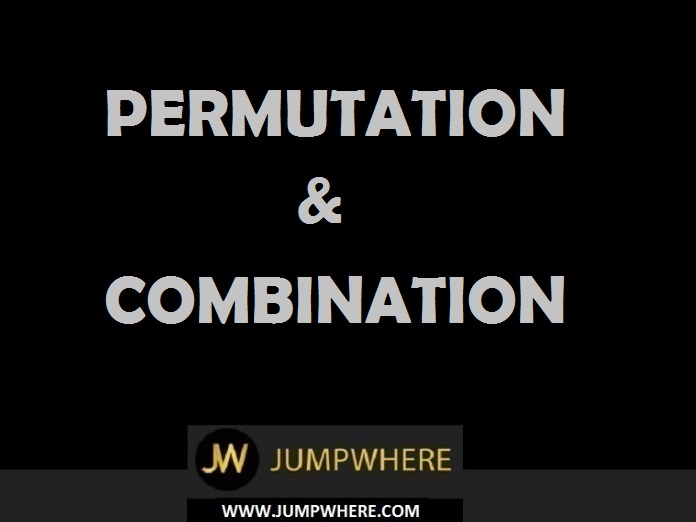[vc_row][/vc_row][vc_column][/vc_column][vc_toggle title=”Explanation / Important formulas:” el_id=”1481454282462-60885454-0285″]
Permutation implies arrangement where order of things is important and includes word formation number formation, circular permutation etc.
- All permutations (or arrangements) made with the letters a, b, c by taking two at a time are (ab, ba, ac, ca, bc, cb).
- All permutations made with the letters a, b, c taking all at a time are (abc, acb, bac, bca, cab, cba).
Number of Permutations:
Number of all permutations of n things, taken r at a time, is given by:
nPr = n(n – 1)(n – 2) … (n – r + 1) = n! / (n – r)!
Examples:
- 6P2 = (6 x 5) = 30.
- 7P3 = (7 x 6 x 5) = 210.
More information: https://en.wikipedia.org/wiki/Permutation
Combination means selection where order is not important and it involves selection of team forming geometrical figures, distribution of things etc.
Examples:
- Suppose we want to select two out of three boys A, B, C. Then, possible selections are AB, BC and CA. [Note: AB and BA represent the same selection]
- All the combinations formed by a, b, c taking ab, bc, ca.
- The only combination that can be formed of three letters a, b, c taken all at a time is abc.
- Various groups of 2 out of four persons A, B, C, D are: AB, AC, AD, BC, BD, CD.
- Note that ab ba are two different permutations but they represent the same combination.
Number of Combinations:
The number of all combinations of n things, taken r at a time is:
nCr = n ! / [(r!)(n-r)]! = [n(n-1)(n-2)…. To r factors] / r!
Note: nCn = 1 and nC0 = 1 , nCr = nC(n – r)
Examples:
- 11C4 = (11 x 10 x 9 x 8) / (4 x 3 x 2 x 1) = 330
- 16C13 = 16C(16 – 13) = 16C3 = 16 x 15 x 14 / 3!= (16 x 15 x 14) / (3 x 2 x 1) = 560
Factorial Notation
Let n be a positive integer. Then, factorial n, denoted n! is defined as:
n! = n(n – 1)(n – 2) … 3.2.1.
Examples:
- We define 0! = 1.
- 4! = (4 x 3 x 2 x 1) = 24.
- 5! = (5 x 4 x 3 x 2 x 1) = 120.
More information: https://en.wikipedia.org/wiki/Combination
[/vc_toggle][vc_toggle title=”Instructions to take Aptitude Test” el_id=”1481454372988-cd8f0f96-30f0″]
- Click on start to start taking the test.
- Click on the option (A, B, C or D) to figure out the right answer.
- You can answer multiple times till you get the right answer.
- Once you get the right answer, explanations (if any) for the same will be showcased down.
- On click of list, you get to see total no of questions, no of questions you answered and no of questions pending to answer.
- On click of question number you will go to that particular question.
- On click of END your test will end.
- On click of ‘Get Results’ you will get to see correct answer for each questions.
[/vc_toggle][vc_toggle title=”Test – Permutation and Combination” open=”true” el_id=”1481454458410-9a4a39ac-c8b7″]
Permutation and combination - Question and Answers
Question 1 |
266 | |
5040 | |
11760 | |
86400 |
= (8C5 X 10C6)
= {(8*7*6/3*2*1)*(10*9*8*7/4*3*2*1)}
= 11760
Question 2 |
16P3 | |
16C3 | |
16! | |
72 |
Question 3 |
564 | |
645 | |
735 | |
756 |
(7 x 6 x 5)/(3x2x1) x (6 x 5/2x1) + (7C3 x 6C1) + (7C2)
=525 +(7x6x5/3x2x1 x 6) + (7x6/2x1)
= (525 + 210 + 21)
=756
Question 4 |
360 | |
480 | |
720 | |
5040 |
When the vowels EAI are always together, they can be supposed to form one letter.
Then, we have to arrange the letters LNDG (EAI).
Now, 5 (4 + 1 = 5) letters can be arranged in 5! = 120 ways.
The vowels (EAI) can be arranged among themselves in 3! = 6 ways.
Required number of ways = (120 x 6) = 720.
Question 5 |
810 | |
1440 | |
2880 | |
50400 |
Thus, we have CRPRTN (OOAIO).
This has 7 (6 + 1) letters of which R occurs 2 times and the rest are different.
Number of ways arranging these letters = 7!/2! = 2520.
Now, 5 vowels in which O occurs 3 times and the rest are different, can be arranged
in 5!/3! = 20 ways.
Required number of ways = (2520 x 20) = 50400.
Question 6 |
210 | |
1050 | |
25200 | |
21400 |
(7C3 x 4C2)
(7*6*5/3*2*1) * (4*3/2*1)
=210
Number of groups, each having 3 consonants and 2 vowels = 210.
Each group contains 5 letters.
Number of ways of arranging
5 letters among themselves = 5!
= 5 x 4 x 3 x 2 x 1
= 120.
Required number of ways = (210 x 120) = 25200.
Question 7 |
72 | |
144 | |
360 | |
720 |
Required number of ways =6!/(1!)(2!)(1!)(1!)(1!)
= 360.
Question 8 |
63 | |
90 | |
126 | |
45 |
(7C2 x 3C1) =
(7*6/2*3) = 63
Question 9 |
40 | |
400 | |
5040 | |
2520 |
Required number of words = Number of arrangements of 10 letters, taking 4 at a time..
= 10P4.
= (10 x 9 x 8 x 7).
= 5040.
Question 10 |
10080 | |
4989600 | |
120960 | |
None of these |
Thus, we have MTHMTCS (AEAI).
Now, we have to arrange 8 letters, out of which M occurs twice, T occurs twice and the rest are different.
Number of ways of arranging these letters = 8!/(2!)(2!) = 10080.
Now, AEAI has 4 letters in which A occurs 2 times and the rest are different.
Number of ways of arranging these letters = 4!/2! = 12..
Required number of words = (10080 x 12) = 120960.
Question 11 |
120 | |
720 | |
4320 | |
2160 |
When the vowels OIA are always together, they can be supposed to form one letter..
Then, we have to arrange the letters PTCL (OIA)..
Now, 5 letters can be arranged in 5! = 120 ways..
The vowels (OIA) can be arranged among themselves in 3! = 6 ways..
Required number of ways = (120 x 6) = 720
Question 12 |
159 | |
194 | |
205 | |
209 |
number of ways = (6C1 x 4C3) + (6C2 x 4C2) + (6C3 x 4C1) + (6C4)
= (6C1 x 4C1) + (6C2 x 4C2) + (6C3 x 4C1) + (6C2)
=(6*4) +((6*5/2*1) *(4*3/2*1)) + ((6*5*4/3*2*1)*4)+(6*5/2*1)
= (24 + 90 + 80 + 15)
= 209.
Question 13 |
5 | |
10 | |
15 | |
20 |
The tens place can now be filled by any of the remaining 5 digits (2, 3, 6, 7, 9). So, there are 5 ways of filling the tens place.
The hundreds place can now be filled by any of the remaining 4 digits. So, there are 4 ways of filling it.
Required number of numbers = (1 x 5 x 4) = 20.
Question 14 |
266 | |
5040 | |
11760 | |
86400 |
(8C3 x 10C4)
= (8 x 7 x 6 x/3 x 2 x 1) x (10 x 9 x 8 x 7 /4 x 3 x 2 x 1)
=11760 = 11760.
Question 15 |
32 | |
48 | |
64 | |
96 |
Required number of ways = (3C1 x 6C2) + (3C2 x 6C1) + (3C3)
=(3* 6x5/2x1) + (3x2/2x1 * 6) + 1
= (45 + 18 + 1)
= 64.
Question 16 |
32 | |
48 | |
36 | |
60 |
Let us mark these positions as under: (1) (2) (3) (4) (5) (6)
Now, 3 vowels can be placed at any of the three places out 4, marked 1, 3, 5.
Number of ways of arranging the vowels = 3P3 = 3! = 6.
Also, the 3 consonants can be arranged at the remaining 3 positions.
Number of ways of these arrangements = 3P3 = 3! = 6.
Total number of ways = (6 x 6) = 36
Question 17 |
20 | |
18 | |
17 | |
25 |
The second digit can be any one of 1,2,3,4,5,6,7,8,91,2,3,4,5,6,7,8,9
i.e. There are 9 choices for the second digit.
Thus, there are 2×9=2×9= 18 multiples of 5 from 10 to 95.
Question 18 |
456 | |
522 | |
594 | |
500 |
There are 99 choices for the number.
The letter can be chosen in 6 ways.
Number of possible bus routes are 99×6=99×6= 594
Question 19 |
20 | |
15 | |
45 | |
24 |
=> By the multiplication (counting) rule,
Total number of solutions=4×3×2==4×3×2= 24
Question 20 |
17576 | |
17654 | |
14789 | |
16872 |
Having chosen this, the second letter can be chosen in 26 ways.
=> The first two letters can be chosen in 26×26=67626×26=676 ways
Having chosen the first two letters, the third letter can be chosen in 26 ways.
=> All the three letters can be chosen in 676×26=17576676×26=17576 ways.
It implies that the maximum possible number of five letter palindromes is 17576 because the fourth letter is the same as the second letter and the fifth letter is the same as the first letter.
Question 21 |
30 | |
40 | |
60 | |
59 |
Out of 5 given digits any one can take the unit's place. This can be done in 5 ways ------- (i).
After filling the unit's place, any of the four remaining digits can take the ten's place..
This can be done in 4 ways ------- (ii).
After filling in ten's place, hundred's place can be filled from any of the three remaining digits..
This can be done in 3 ways ------- (iii).
=> By counting principle, the number of 3 digit numbers =5×4×3==5×4×3= 60
Question 22 |
63 | |
45 | |
72 | |
85 |
The bus from B to C can be selected in 4 ways.
The bus from C to D can be selected in 2 ways.
The bus from D to E can be selected in 3 ways.
So, by the General Counting Principle, one can travel from A to E in 3×4×2×3=3×4×2×3= 72 ways
Question 23 |
630 | |
569 | |
654 | |
720 |
The number of permutations of n objects isn!=n.(n−1).(n−2)...2.1n!=n.(n−1).(n−2)...2.1.
Here n=6n=6 and therefore, number of permutations is 6.5.4.3.2.1=6.5.4.3.2.1= 720.
Question 24 |
260 | |
392 | |
723 | |
360 |
This number is 6P4=6(6−1)(6−2)
(6−3)=6×5×4×3=3606P4=6(6−1)(6−2)
(6−3)=6×5×4×3=360
Question 25 |
200ways | |
5400ways | |
3600ways | |
3505ways |
Case 1:
Suppose Anju is allotted bed number 1.
Then, Parvin cannot be allotted bed number 2.
So Parvin can be allotted a bed in 5 ways.
After allotting a bed to Parvin, the remaining 5 students can be allotted beds in 5! ways.
So, in this case the beds can be allotted in 5×5!=6005×5!=600 ways.
Case 2:
Anju is allotted bed number 7.
Then, Parvin cannot be allotted bed number 6
As in Case 1, the beds can be allotted in 600 ways.
Case 3:
Anju is allotted one of the beds numbered 2,3,4,52,3,4,5 or 66
Parvin cannot be allotted the beds on the right hand side and left hand side of Anju's bed.
For example, if Anju is allotted bed number 2, beds numbered 1 or 3 cannot be allotted to Parvin.
Therefore, Parvin can be allotted a bed in 4 ways in all these cases.
After allotting a bed to Parvin, the other 5 can be allotted a bed in 5! ways.
Therefore, in each of these cases, the beds can be allotted 4×5!=4804×5!=480 ways.
=> The beds can be allotted in:
2×600+5×480=1200+2400=2×600+5×480=1200+2400= 3600 ways
Question 26 |
28756 | |
28756 | |
17280 | |
16547 |
They can be arranged in 4! ways.
Similarly, there are 5 novels.
They can be arranged in 5! ways.
And there are 3 plays.
They can be arranged in 3! ways.
So, by the counting principle all of them together can be arranged in 4!×5!×3!=4!×5!×3!= 17280 ways
Question 27 |
465765 | |
678954 | |
103680 | |
876524 |
These three objects can be arranged in 3!=63!=6 ways.
Let us fix one of these 6 arrangements.
This may give us a specific order, say, novels -> fairy tales -> plays.
Given this order, the books on the same subject can be arranged as follows.
The 4 books on fairy tales can be arranged among themselves in 4!=244!=24 ways.
The 5 novels can be arranged in 5!=1205!=120 ways.
The 3 plays can be arranged in 3!=63!=6 ways.
For a given order, the books can be arranged in 24×120×6=1728024×120×6=17280 ways.
Therefore, for all the 6 possible orders the books can be arranged in 6×17280=6×17280= 103680 ways.
Question 28 |
17654 | |
17280 | |
56783 | |
78345 |
In each of these arrangements 4 girls can be arranged in 4! ways.
=> Total number of arrangements in which girls are always together
=6!×4!=720×24==6!×4!=720×24= 17280
Question 29 |
330 ways | |
340 ways | |
333 ways | |
348 ways |
We have to find the number of ways of choosing 4 elements of this set which has 11 elements.
This can be done in:
11C4=11×10×9×81×2×3×4=11C4=11×10×9×81×2×3×4= 330 ways
Question 30 |
240ways | |
450ways | |
180ways | |
220ways |
=5C2=5P22!=5×41×2=10=5C2=5P22!=5×41×2=10
Number of ways of choosing 2 white pens from 3 white pens
=3C2=3P22!=3×21×2=3=3C2=3P22!=3×21×2=3
Number of ways of choosing 2 red pens from 4 red pens
=4C2=4P22!=4×31×2=6=4C2=4P22!=4×31×2=6
=> By the Counting Principle, 2 black pens, 2 white pens, and 2 red pens can be chosen in
10×3×6=10×3×6= 180ways.
Question 31 |
11234 | |
21600 | |
37432 | |
37432 |
2 biographies can be selected out of4 in 4C24C2 ways.
Number of ways of arranging novels and biographies: =5C4×4C2=30=5C4×4C2=30
After selecting any 6 books (4 novels and 2 biographies) in one of the 30 ways, they can be arranged on the shelf in 6!=7206!=720 ways.
By the Counting Principle, the total number of arrangements =30×720==30×720= 21600
Question 32 |
1456 | |
1008 | |
1080 | |
1000 |
⇒(7.6). (4.3.2)
⇒1008
Question 33 |
20 | |
30 | |
40 | |
60 |
⇒(5.4/2). (3)
⇒30
Question 34 |
120 | |
240 | |
100 | |
200 |
⇒Required number of ways = (6C3 *5C2)
⇒(6.5.4/3.2)*(5.4/2)
⇒200.
Question 35 |
4320 | |
4563 | |
4632 | |
4700
|
According to the question, vowels should always come together. Therefore, in this case we will treat all the vowels as one entity or one alphabet. This implies, in total there are 6 words (one word which is a group of vowels)
These 6 words can be arranged in 6P6 ways ⇒6P6 = 6!/1! = 6! = 720 WAYS
Also, three vowels in a group may be arranged in 3! ways
⇒3! = 6 ways
Therefore, required number of words = (720*6) = 4320
[/vc_toggle][vc_empty_space][vc_btn title=”More Aptitude Question” color=”warning” size=”lg” align=”center” button_block=”true” link=”url:https%3A%2F%2Fjumpwhere.com%2Faptitude%2F||”]


